Ricinus Semen, Castor SeedCataputia; Arand (Unani)Dan Khra དན་ཁྲ (Tibetan) |

|

|
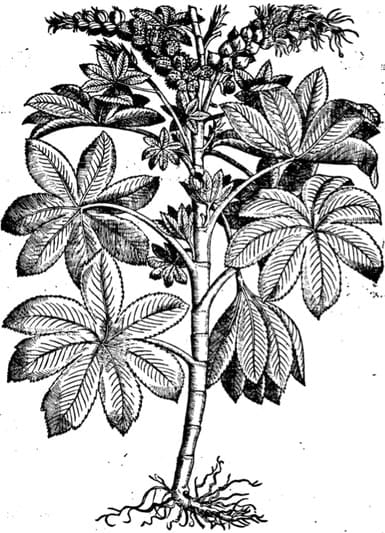 New Kreüterbuch, Matthiolus, 1563
New Kreüterbuch, Matthiolus, 1563
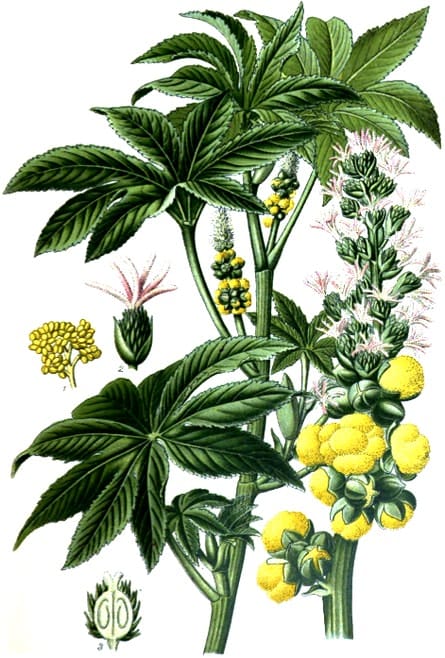 Atlas des plantes de jardins, Klincksieck, 1896
Atlas des plantes de jardins, Klincksieck, 1896 |
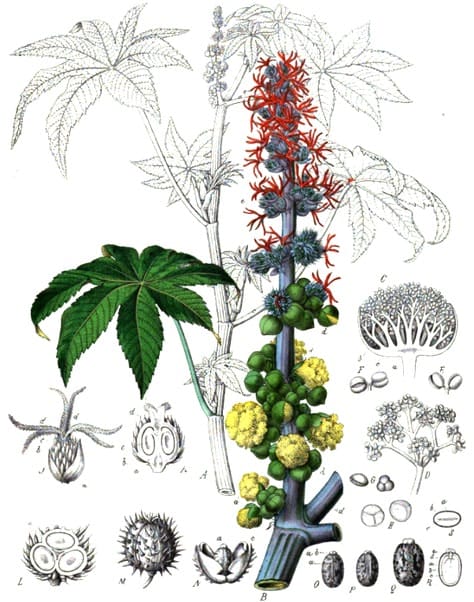 Atlas der officinellen pflanzen (2), Felix, 1899
Atlas der officinellen pflanzen (2), Felix, 1899 |
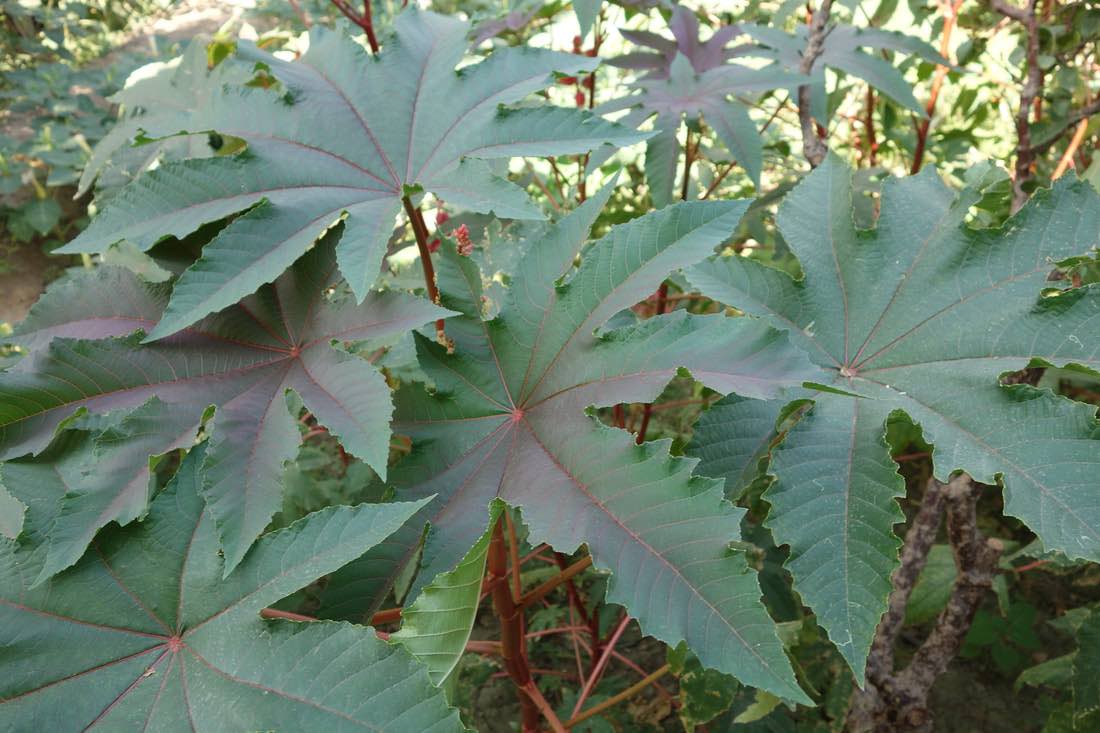
Castor leaves (above) and Seed pods (right) (Adam, 2017) |
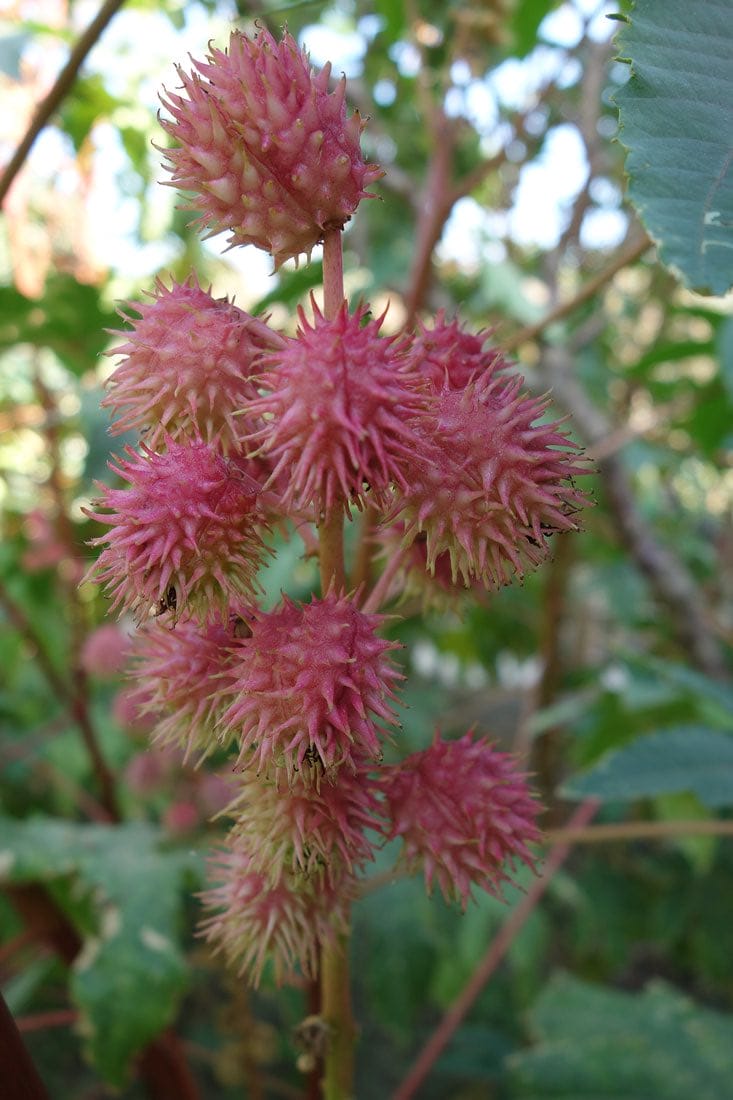
|
Botanical name:Ricinus communis Parts used:1. Prepared Seed (toxic) 2. Expressed Oil (non-toxic) 3. Root is also used in Ayurveda Temperature & Taste:SEED: Neutral (slightly Warm), dry. Pungent, Sweet. Toxic OIL: Neutral, moist. Pungent and Sweet Classifications:2F. PURIFYING. 2K. RESOLVENT 3Q. ANTHELMINTIC Preparers and Purgers of Phlegm TCM: S. Worms and Parasites T. External Medicines |
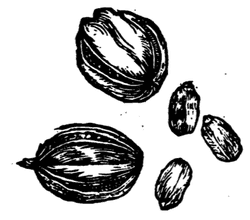 Castor seed
Castor seedParkinson, Theatrum Botanicum, 1640 |
Uses:
1. Drastic Purge:
-internally as a drastic purge to purge water from the bowels.
2. Purges Phlegm and Damp, Relieves Swelling:
-Asthma
-“Eliminates Swelling” (Li Shi Zhen)
-Hepatitis, pelvic inflammation
-traditionally to promote Labor and expel the placenta (should not be used like this today–use the oil instead)
3. Clears Wind-Damp, Dredges the Orifices and Collaterals:
-“It dredges through the orifices, Channels and Collaterals. It stops pains due to various causes” (Li Shi Zhen)
-Gout, Lumbago, Rheumatism, Sciatica (Ayurveda, West)
-Epilepsy, Headache including severe intermittent Headache
-“good for treating hemiplegia with deviation of the mouth and eye, aphonia and lockjaw” (Li Shi Zhen)
-“Diseases of the 7 Orifices” (Li Shi Zhen)
4. Externally:
-“important in treating external diseases”. (Ben Cao Gang Mu)
-“disperse pus and remove toxin” (Ben Cao Gang Mu)
-paste of the seeds can be applied to boils, Abscesses and Swollen Lymph nodes.
-paste is applied to the palms and soles of the feet for Retained Placenta.
-paste may also be applied to Joint Pain, Neuralgias and Facial Paralysis.
Dose:
ROASTED or PREPARED POWDERED SEED: 100–200mg (2–3 grains), up to 650mg (10 grains) has been given for scrofula, swellings etc.
The well-scorched seeds with shells removed can be taken in doses of 2–3 seeds before bed for Scrofula, gradually increasing to 12.
Preparation:
1. Prepared Castor Seed:
Seeds are commonly shelled, then scorched or roasted until blackened to lessen the toxicity. This is then suitable for internal use.
2. Salt-prepared Seed:
Stew the seed in Salt Water for half a day, then wash, remove the shell, grind to powder and dry.
Correctives:
1. Tragacanth
2. Mastic (Unani)
Substitutes:
1. Castor seed has been used as a substitute for both Scammony and Colocynth
2. Castor leaves have similar effects to the Seeds, but are less active.
3. ‘similar to Croton Ba Dou in quality and taste’. (Li Shi Zhen)
Main Combinations:
1. To strongly purge Phlegm and Water, prepared Castor seed, with prepared Spurge bark, Citron peel, Yellow Myrobalan, Indian Spikenard and Cinnamon (as in Pills of Spurge)
2. Purgative:
i. for Wind (Vata) constitutions, prepared Castor seed (1 part) Chebulic Myrobalan (4 parts)
ii. Arthritis, with decoction of Bdellium and Dashmoola (the 10 roots)
3. Rheumatism, prepared Castor seed (2 parts), Chebulic Myrobalan (1 part) (Ayurveda)
4. To promote Labor, a paste of the seeds was applied to the palms and soles of the feet. This should not be repeated today. (Da Ming)
5. Enema for Worms, Castor oil (3 oz.), Decoction of Linseed (4 oz.). (Picettario Clinico, Padua, 1825)
6. Externally for Psoriasis, prepared Castor seed, White Dittany (Bai Xian Pi), Carrot seed (He Shi), Phellodendron Huang Bai, Dang Gui, Rehmannia Sheng Di Huang, Realgar (Xiong Huang), made into a plaster with Beeswax
7. Migraine, beat Castor seed with Frankincense and salt and apply to the temples. (Li Shi Zhen)
8. Painful swelling, apply a paste of Castor seed. (Li Shi Zhen)
9. Prolapsed Uterus following childbirth, apply a paste to the point 3 inches below the umbilicus. (Li Shi Zhen)
Major Formulas
Pills of Spurge
Punarnavadi Guggulu (Boerhaavia and Bdellium Pills)
Cautions:
1. Toxic; overdose can be lethal It was accounted far more safe and suitable for external use but should be used cautiously internally and only after proper preparation.
2. Not used during Pregnancy
3. Not suitable for the very young, very old, or weak.
Toxicity:
1. Symptoms come hours, or even days after ingestion and include a burning feeling of the throat, trembling, diarrhea. Death can occur from cardiac arrest. The whole plant contains a toxic principle ricin, which is, however, not present in the Oil. Ingestion of 2 beans has been said to be enough to kill an adult, although other sources (PDR) say 12 Castor beans are fatal for an adult; much less for children.
2. Over a 28 year period, the incidence of severe poisonings in Switzerland related to the use of Ricinus was 3 cases. All had diarrhea, one had toxic megacolon.
3. Ricin poisoning causing death after ingestion of herbal medicine
4. Anaphylactic shock following castor bean contact: a case report
Antidotes
1. Milk Inhibits the Biological Activity of Ricin
2. Vomiting was used as soon as possible.
3. Sealed Earth or Armenian Earth
3. Theriac or Mithridate, 2 drams with Honey water or wine.
Main Preparations used:
Prepared Castor Seed; Castor Oil
|
‘The Castor plant is called in Sanskrit Eranda, Ruvu, Ruvuka and Uruvuka, and the red variety Raktairanda; the root and the oil obtained from the seeds have been used medicinally by the Hindus from a very remote period, and are mentioned by Susruta. Both root and oil are described as purgative and useful in costiveness, flatulence, rheumatism, fever and inflammatory affections; on account of its efficacy in rheumatism the plant bears the synonym of Vatari (vata-ari). As a purgative the oil is directed to be taken with cow’s urine or an infusion of ginger or the decoction of the ten roots known as dasamula (see Vol. I., p. 243). The seeds freed from the husks and germs, and boiled in milk and water, form a decoction which is given in rheumatism; a decoction of the root with carbonate of potash is also prescribed, and most compound medicines given in rheumatic and neuralgic affections contain the root. The leaves are applied to the breast to stop the secretion of milk, and, boiled with the root in goat’s milk and water, they are used as a local application in ophthalmia. When applied to the abdomen they are popularly thought to promote the menstrual flow; in Govardhana (203), the halikaradhu, or “peasant woman,” is represented as lying in pain upon the leaves of the Eranda. In the proverbial language of the Indians the Castor plant is emblematic of frailty; they say :— Naukri arand ki jar hai (service is like the root of the Castor plant). The Arabs appear to have first become acquainted with the tree in India, as they call the seeds Simsim-el-hindi, “Indian Sesamum,” and the plant Khirvaa, a word which signifies any weak or frail plant; the properties they attribute to it are also those mentioned by Sanskrit writers. Again, in the Saptasataka of Hala, we find the large and swelling breasts of the peasant girl likened to the Eranda leaf, and in Arabic we have the expression [?] applied to a beautiful and tender girl. R. communis is the Bidanjir and Kinnatu of the Persians; it also bears various local names, such as Gerchak in the Shahpur District, and Buzanjir, “goat’s fig,” in Khorasan. Aitchison notices its cultivation round the borders of fields in the latter province, and in the Harirud District, for the sake of the oil which is used as a lamp oil, and says that the peasantry are unacquainted with its purgative properties. The plant was cultivated in Southern Europe at a very early date; it is the [?] of Herodotus, the [?] of Theophrastus (H.P .i.,16; CP. ii.), and the [?] or [?] of Dioscorides (iv., 15b), who observes that the name [?] is given to the seed on account of its resemblance to an insect known by that name (Ixodes Ricinus, Latr.). He also notices Castor oil and its medicinal use. It is the Ricinus or Cicus of Pliny (15,7), “a tree which grows in Egypt in great abundance ;by some it is known as croton, by others as sili, and by others, again, as wild sesamum: it i not so very long since this tree was first introduced here. Eaten with food the oil is repulsive, but it is very useful for burning in lamps.” The Jews and Abyssinian Christians say that it was under this tree that Jonah sat, but in the English version the Hebrew word “Kikajon” is translated “gourd.” For a history of the plant in Europe, the Pharmacographia may be consulted. Mahometan medical writers describe two kinds, red and white: the red is said to be the most active. They consider the oil a powerful resolvent and purgative of cold humors, and prescribe it in palsy, asthma, colds, colic, flatulence, rheumatism, dropsy and amenorrhoea; of the seeds, 10 kernels rubbed down with honey are sufficient as a purge. A poultice of the crushed seeds is used to reduce gouty and rheumatic swellings, and inflammation of the breasts of women during lactation. The leaves have similar properties, but in a less degree. The fresh juice is used as an emetic in poisoning by opium and other narcotics; made into a poultice with barley meal it is applied to inflammatory affections of the eye. The root-bark is used as a purgative and alterative in chronic enlargements and skin diseases; it is also applied externally. In modern medicine Castor oil is much valued as a non-irritant purgative; a drop is sometimes dropped into the eye to allay irritation, and, strange to say, the leaves are applied locally in Europe to promote the secretion of milk, whereas in India the native practice of applying them to stop the secretion of milk is recognised in the Government hospitals under European superintendence. A fluid extract of the leaves has also been recommended in Europe as a lactagogue. As a purgative the oil is best administered in the early morning on an empty stomach, when about one drachm will usually be found sufficient, at other times at least half an ounce will be required. Various fluids have been recommended to conceal the taste of the oil, such as brandy, peppermint water, &c, but the decoction of fresh ginger, as used in |
India, is, we think, the best vehicle. The above remarks apply to cold drawn oil; the bazar oil extracted by boiling is more active, and, as it is not always carefully prepared, it may contain the acrid principle of the seed and give rise to disagreeable symptoms. The alleged antirheumatic properties of the plant so insisted upon by Hindu and Mahometan physicians are worthy of being tested by careful clinical observation. M. H. Meyer (Pharm. Zeitsch. f. Russland, xxx., p. 282, 1891), in order to decide the question as to the purgative properties of ricinoleic acid, prepared that substance perfectly pure, also its glyceride, and ricinelaidic acid. All these preparations were administered to cats, and acted as purgatives. The author concludes that there is no reason to suppose that Castor oil contains any purgative principle other than ricinoleic acid. Dr. H. Stillmark has discovered in the seeds an albuminoid body which he has named “Ricin.” This, however, does not appear to be the purgative principle. Its action, whether given by the mouth or hypodermically, is to produce hemorrhagic inflammation of the gastro-intestinal tract, affecting primarily the small intestines, and probably obstructing the bile duct, since there is usually extreme fullness of the gall bladder; the inflammation also extends to the vesical mucous membrane. Diarrhoea is by no means constant. The drowsiness and convulsions which occurred in some of his experiments on animals he attributes to possible thrombosis of the cerebral vessels. The lethal dose of ricin for man he calculates to be 6.0 milligrams for a man weighing 60 kilograms, this generally being equal to about ten ordinary seeds, although Christison once had a fatal case, where only three seeds had been swallowed, and, on the other hand, a case is on record in which a person who had eaten 17 seeds, recovered. Ricin appears to have a peculiar effect upon blood, causing a rapid conglomeration of the red corpuscules, together with the formation of a substance like fibrin. One part of ricin to 60,000 of defibrinated blood is sufficient to cause a separation of the serum, so that the latter is capable of being passed through a filter. Crotonoleic acid, which exists in croton seeds, was found to be quite distinct from ricin. The results obtained by Dr. Stillmark find further confirmation in a note in the Medical Recorder (July, p. 299), in which it is stated that fifteen children, under six years of age, poisoned by eating castor seeds, suffered from severe vomiting and prostration, but not from catharsis. Ehrlich (Deutsche Med. Wochenschr., No. 32, p. 976, 1891) reports some interesting experiments with ricin. He found that injected into the veins of animals, it is fatal in doses of three milligrams per kilo of body-weight; taken internally it is a hundred times less active, but still so poisonous that 0.18 gram is a fatal dose for an adult man. He found different animals to be unequally affected by it; guinea pigs were especially susceptible to the poison, but white mice much less so. The symptoms were diarrhoea and prostration: on post mortem examination the appearances in some cases were such as are seen in cholera, but more frequently there was a haemorrhagic condition of the intestines and often of the subcutaneous cellular tissue. Ehrlich also succeeded in rendering animals insusceptible to the poison by administering gradually increasing doses internally: at the end of two months of this treatment he found that mice could bear a dose of 5 decigrams of ricin (sufficient to kill an adult man), the fatal dose for an unprotected mouse being 35 milligrams. The immunity obtained was still more marked in experiments on the conjunctiva; under ordinary circumstances touching the membrane with a 1 per cent, solution of ricin produced intense inflammation, but after several weeks of protective treatment the strongest solution could be freely applied without producing any effect. The establishment of the immunity appears to commence suddenly on the sixth day, and continues to increase from that time. The author insists upon the similarity between this sudden immunity and the critical subsidence of fever in certain acute diseases, such as pneumonia, measles, &c, which he considers may also be regarded as indicating the establishment of an immunity in those diseases. Animals in which an immunity to the ricin poison had been established, were found, six months after the cessation of all treatment, to be incapable of being affected by the poison. Ehrlich has also made similar experiments with abrin, the active principle of Abrus precatorius, which he reserves for early publication.’ (Pharmacographia Indica, Dymock, 1893) |
